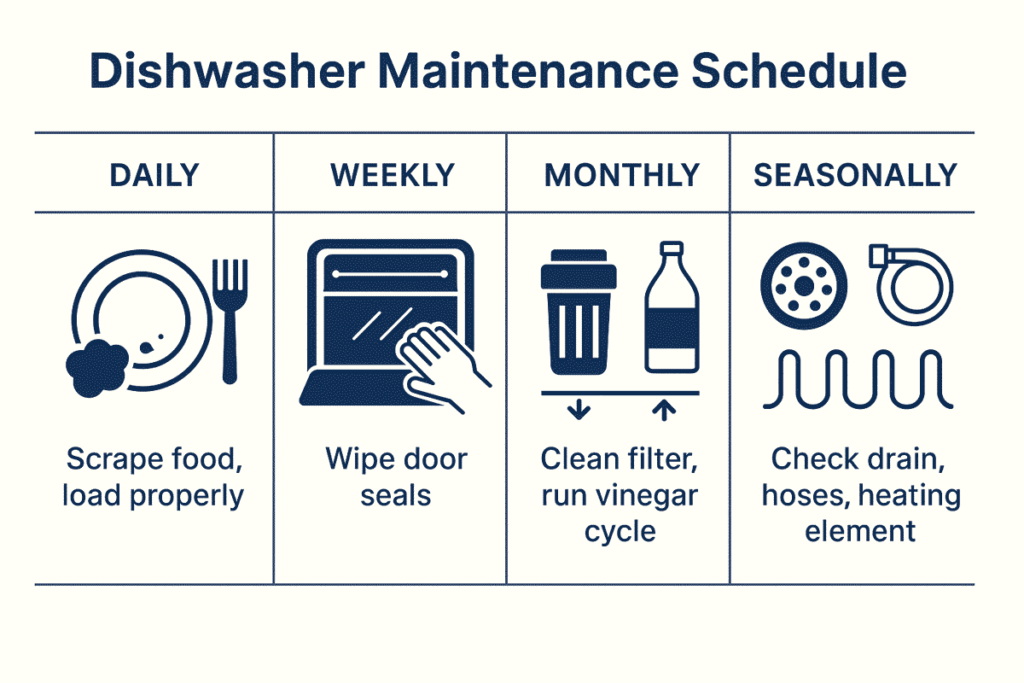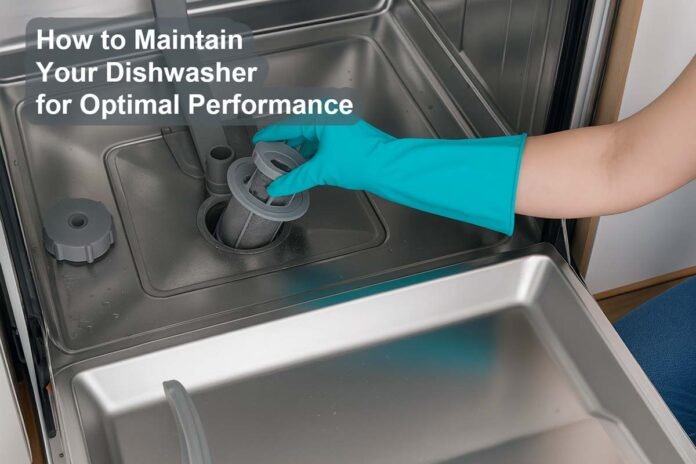Your dishwasher works hard every day to save you time, water, and energy. But without regular maintenance, even the best models can lose efficiency or break down earlier than expected. In this guide, we’ll show you exactly how to maintain your dishwasher — with simple, actionable steps you can do weekly, monthly, and seasonally — to ensure optimal performance and longevity.
Why It’s Important to Maintain Your Dishwasher
Dishwasher maintenance isn’t just about keeping the appliance clean — it’s about keeping your entire kitchen running smoothly. Here’s why it’s essential:
- Save Energy and Water
A well-maintained dishwasher uses less water and electricity per cycle, helping you cut utility bills over time. According to the U.S. Department of Energy, ENERGY STAR-rated dishwashers can save up to 3,870 gallons of water over their lifetime. - Avoid Costly Repairs
Regular cleaning prevents buildup that can damage internal components. Something as simple as a clogged filter or spray arm can lead to breakdowns that cost hundreds to fix. - Improve Cleaning Performance
Dirty filters and spray arms reduce water flow and detergent efficiency, leading to streaky or unwashed dishes. - Extend Appliance Lifespan
With consistent maintenance, most dishwashers last 10+ years. Neglect shortens that dramatically.
💡 Quick Tip: Set a monthly reminder to clean your dishwasher — your dishes (and wallet) will thank you.
How to Maintain Your Dishwasher Daily and Weekly
You don’t need a toolbox or an hour of free time. These easy daily and weekly habits can prevent most dishwasher problems before they start.
🔹 Scrape (Don’t Rinse) Before Loading
Contrary to popular belief, you don’t need to rinse your dishes before loading. In fact, modern dishwashers work better when they detect some food particles, which helps activate the detergent enzymes.
✅ Do this instead:
- Scrape off large food chunks into the trash or disposal.
- Avoid pre-rinsing — it wastes water and can confuse your machine’s sensors.
🛍️ Recommended Product:
Use a silicone food scraper to quickly clean plates without rinsing.
👉 Check top-rated dish scrapers on Amazon
🔹 Load Dishes the Right Way
Proper loading isn’t just about fitting more in — it affects water flow, cleaning coverage, and drying performance.
Here’s how to load efficiently:
- Top rack: cups, glasses, small bowls (angled downward)
- Bottom rack: plates, pots, pans, and larger bowls
- Silverware basket: mix utensils (some up, some down) to prevent nesting
🔗 Related guide: How to Load a Dishwasher Efficiently – Maximize Space & Cleanliness
🔹 Wipe the Door Seals and Edges
The rubber gasket around your dishwasher door traps food particles, grease, and even mold if left uncleaned.
To clean:
- Use a damp microfiber cloth and a solution of equal parts white vinegar and water
- Wipe around the seal, edges, and detergent dispenser weekly
Infographic: Simple Dishwasher Maintenance Schedule
Want a quick overview of how to maintain your dishwasher like a pro? This easy-to-follow schedule breaks down all essential tasks by frequency — daily, weekly, monthly, and seasonally — so your dishwasher stays in top condition year-round.
🧩 Follow the steps below to prevent buildup, improve performance, and extend the life of your appliance:

monthly, and seasonally to maintain your dishwasher and keep it running efficiently.
Why Consistency Matters
When you maintain your dishwasher consistently, you’re not just preventing clogs or funky smells — you’re also protecting your investment. A well-cared-for dishwasher:
- Runs more efficiently
- Uses less water and energy
- Cleans dishes better
- Lasts longer without costly repairs
💡 Pro Tip: Print or save this infographic and keep it near your kitchen cleaning supplies as a reminder!
🛍️ Editor’s Pick: Chemical-free microfiber cleaning cloths are safe for rubber and stainless steel. 👉 See best options on Amazon
Monthly Routine to Maintain Your Dishwasher Deeply
Even if you follow good daily habits, grime, grease, and mineral deposits can still accumulate inside your dishwasher. That’s why a monthly deep clean is crucial — it targets hidden buildup and keeps your machine running like new.
🔹 Clean the Filter
The filter traps food particles and debris. If it’s clogged, your dishwasher will leave residue on dishes and may even start to smell.
How to clean it:
- Remove the bottom rack to access the filter (usually a twist-and-pull mechanism).
- Rinse it under warm water. Use a soft brush to remove stubborn gunk.
- Check the filter housing for buildup and wipe it clean.
🛒 Need a new filter? Some filters wear out over time.
👉 Check compatible dishwasher filters on Amazon
🔹 Run a Cleaning Cycle to Maintain Your Dishwasher
Over time, grease and soap scum build up on the walls and spray arms. A cleaning cycle removes this hidden grime and improves overall performance.
Two effective methods:
🧴 Option 1: Dishwasher Cleaner Tablets
Drop one in the detergent dispenser or bottom rack and run a hot wash.
👉 Best-selling dishwasher cleaners on Amazon
🥄 Option 2: DIY with Vinegar + Baking Soda
- Place a bowl of white vinegar on the top rack and run a hot cycle.
- Sprinkle baking soda on the bottom of the tub and run a short hot cycle again.
💡 Use vinegar only once a month — overuse can damage rubber seals.
🔹 Inspect and Unclog the Spray Arms
Minerals and food bits can block the tiny holes in your spray arms, reducing water pressure and coverage.
Here’s what to do:
- Remove spray arms (check your manual or just unscrew gently)
- Rinse under running water
- Use a toothpick or paperclip to unclog each nozzle
- Reinstall and rotate to ensure they spin freely
🛠️ Tip: If arms are cracked or warped, replacements are affordable and easy to install.
👉 Browse dishwasher spray arms on Amazon
⚙️ Seasonal Maintenance Checks (Every 3–6 Months)
Every few months, it’s smart to check deeper components that influence your dishwasher’s performance and safety.
🔹 Clean the Drain Area
Food scraps, broken glass, and debris can collect in the drain area, causing odors or even flooding.
- Remove the lower spray arm and filter to access the drain
- Use gloves and a flashlight to remove any visible gunk
- Wipe the area with paper towel or a mild cleaner
🧽 Pro tip: Use a drain snake tool if water is draining slowly
👉 Find mini drain snakes on Amazon
🔹 Check the Inlet Valve and Hoses
Water inlet issues can lead to long cycles, poor cleaning, or leaks.
- Inspect the hose for kinks or mineral buildup
- Make sure clamps are tight and the valve isn’t leaking
- If you live in a hard water area, use a dishwasher descaler every 3–6 months
👉 Top-rated dishwasher descalers for hard water – See Amazon Deals
🔹 Test the Heating Element
If your dishes are still wet or cloudy after a cycle, the heating element may be underperforming.
- After a hot wash, open the dishwasher and check if the dishes feel warm
- Look for discoloration or limescale on the element (usually a metal rod on the bottom)
🔧 Need a replacement part?
Heating elements are model-specific.
👉 Search by brand and model on Amazon
Bonus Tips for Hard Water Areas
If you live in a region with hard water, your dishwasher faces extra challenges: limescale buildup, cloudy glasses, and residue on dishes. Fortunately, there are a few simple ways to fight back.
🔹 Use a Rinse Aid Regularly
Rinse aid helps prevent water spots and improves drying by reducing surface tension. It’s especially helpful in hard water conditions.
✅ Look for rinse aids labeled “for hard water” or “spot-free drying.”
🛍️ Top Pick:
Finish Jet-Dry Rinse Aid – America’s #1 selling rinse aid
👉 Check price on Amazon
🔹 Add Dishwasher Salt (If Your Model Allows)
Some European-style dishwashers (Bosch, Miele) include a built-in water softener that uses dishwasher salt to prevent limescale.
- Only use dishwasher-specific salt — never table salt
- Refill as indicated by your machine’s light or manual
✅ Best Option:
Finish Dishwasher Salt – Purified, coarse-grain salt
👉 See on Amazon
🔹 Consider a Whole-House or Inline Water Softener
For long-term prevention, especially if you have multiple appliances affected by hard water, an inline or whole-home softening system may be worth the investment.
🔗 Explore more: Best Dishwashers for Hard Water in the US – 2025 Guide
🔁 When Dishwasher Maintenance Isn’t Enough: Time to Replace It?
Even with excellent maintenance, no appliance lasts forever. If your dishwasher shows any of these signs, it may be time for an upgrade.
🚩 Signs It’s Time to Replace:
- Dishes consistently come out dirty or wet
- Loud grinding or humming noises during cycles
- Frequent leaks or standing water
- Age over 10–12 years
- Repairs are costing more than half the price of a new unit
💡 ENERGY STAR-rated dishwashers use less energy and save up to $35 per year on utility bills compared to older models.
🛒 Ready for an Upgrade?
We’ve researched the top-rated, energy-efficient dishwashers that offer better cleaning, quieter performance, and smart features for modern kitchens.
👉 Compare the Best Dishwashers for 2025 – Expert Picks & Buyer’s Guide
📌 Recommended Products for Dishwasher Maintenance
Below is a hand-picked selection of products to help you maintain your dishwasher efficiently and affordably. All items are available on Amazon with high user ratings and fast U.S. shipping.
| Product | Use | Price | Rating | Link |
|---|---|---|---|---|
| Finish Dishwasher Cleaner Tablets | Monthly cleaning | $ | ⭐⭐⭐⭐⭐ | Check on Amazon |
| Affresh Dishwasher Cleaner | Remove limescale & odor | $ | ⭐⭐⭐⭐ | View on Amazon |
| Finish Jet-Dry Rinse Aid | Drying & spot prevention | $ | ⭐⭐⭐⭐⭐ | Buy on Amazon |
| Whirlpool Dishwasher Filter | Filter replacement | $$ | ⭐⭐⭐⭐ | Shop on Amazon |
| Ecozone Descaler Tablets | Hard water limescale control | $$ | ⭐⭐⭐⭐ | See on Amazon |
| Microfiber Cleaning Cloths | Safe interior cleaning | $ | ⭐⭐⭐⭐⭐ | Check price on Amazon |
💬 Tip: Consider bundling cleaner + rinse aid in a maintenance kit to save money.
❓ FAQs About Dishwasher Maintenance
(Тази секция е подходяща за включване на FAQPage Schema за подобрена видимост в Google SERP rich results.)
🔹 How often should I clean my dishwasher?
You should clean the filter and run a cleaning cycle at least once a month. Wipe door seals weekly and inspect spray arms every 2–3 months.
🔹 Can I use vinegar to clean my dishwasher?
Yes — white vinegar is a safe, natural option to dissolve grease and remove odor. However, don’t overuse it, as acidic cleaners can wear down rubber parts over time.
🔹 Do dishwasher cleaners really work?
Yes. Specialized cleaners like Finish or Affresh are designed to remove limescale, grease, and hidden grime that regular detergent can’t reach.
👉 Check best-selling dishwasher cleaners on Amazon
🔹 Is it OK to leave the dishwasher door closed after a cycle?
It’s best to leave the door slightly open after each cycle to prevent moisture buildup and reduce the risk of mold or odor.
🔹 How long should a dishwasher last?
With proper maintenance, a quality dishwasher should last 10 to 12 years. If yours is older and underperforming, consider upgrading.
👉 See our picks for Best Dishwashers for 2025
🛒 Final Thoughts – Keep Your Dishwasher in Top Shape
Maintaining your dishwasher doesn’t have to be complicated — but it does need consistency. By following the daily, monthly, and seasonal tips in this guide, you’ll:
- Get cleaner dishes with less effort
- Save money on repairs and energy
- Extend the lifespan of your machine
Whether you’re using a compact apartment model or a high-end Bosch or KitchenAid unit, the basics stay the same.
✅ Ready to Upgrade Your Dishwasher Care Routine?
🧼 Stock up on the best dishwasher maintenance products today:
👉 Shop Cleaning Essentials on Amazon
🛠️ Want a more powerful, energy-efficient dishwasher?
👉 Compare Top Dishwashers for 2025





